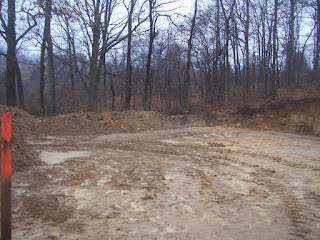It has been more than two months since my last entry. Frankly, I've been discouraged with our progress and have had little to say or show for most of that time.
I have worked with an engineer in New York to verify that the posts and beams we want to use are strong enough to support the living roof and to define the concrete requirements for the house to be sure it will both support the posts and hold back the hillside to the north.
While that exchange was going on I have been gathering cost information for electricity, water, septic system, excavation and various items we will need in the new building.
Then, with the engineer's specifications in hand, it was time to get estimates for the concrete work. This proved to be more difficult than I ever expected.
The concrete specs are not typical in the eyes of all the contractors I've contacted. There are very large piers under some of the most loaded posts. The walls' thicknesses change from south to north, as do the depths and thicknesses of footings. Part of the north wall will have nearly 9 feet of hillside against it, and it is mostly clay soil, about as unstable as any soil could be. Insufficient strength in the wall or the post supports, or the posts and beams themselves for that matter, could allow us to be found some day under a pile of dirt from the hill or the roof.
I contacted five concrete contractors. All but one were given all the specs, plans and pictures. One never got that far as he was offered a large commercial project before we met. One called back to ask more questions, then never contacted us again. Two presented quotes that didn't pick up correct wall and footing lengths from the drawings. Almost all said they would rather use a different rebar configuration than the specs called for.
I encouraged all of them to visit the site so they wouldn't be surprised later by the access restrictions (and be tempted to cut some corners to make up for any extra effort the site required that they hadn't considered when bidding).
I was careful to tell everyone that we would be lining the footings with insulated panels before the concrete was poured. One said, "I won't pour concrete footings on top of insulation." I replied, "Then I guess we're done talking." As you might guess, he stayed to get the specs and submitted a bid.
Each of these exchanges seemed to take a week or so, even the guy who backed out didn't do so until I had waited about 10 days to meet with him.
Finally, after decided that we would deal with the floor and piers separately, I asked for new bids and got one that we can live with. We'll check out some of their projects before we start, but it looks like we've finally got our concrete work lined up.
Yesterday I called our excavator and got on his schedule for next week. The weather has been good and is forecast to be nice for about a week more at least, so we're planning to get this project started.
I have tried to keep busy while waiting for a good concrete bid. Next I'll post a few pictures taken since August.
 Ruts we made can be seen on the right side of the rocks so I still need to use a hoe or shovel to fill in a few of them and to cut some small slots where the ruts are running across the flow of the stream so the water won't pool up anywhere. Let's see what it looks like in the spring.
Ruts we made can be seen on the right side of the rocks so I still need to use a hoe or shovel to fill in a few of them and to cut some small slots where the ruts are running across the flow of the stream so the water won't pool up anywhere. Let's see what it looks like in the spring.































